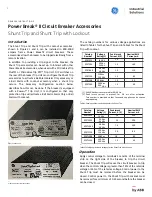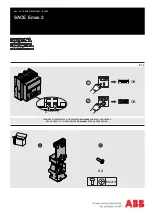
.
. �
.·(
with the wiring diagrams applying to the installa
tion. The secondary and control connections for all
outgoing connections are wired to terminal blocks
accessible to the conduit connections.
Control connections between housings are pro
vided through openings in the side sheets of the
switchgear. When shipment is made in groups of
several units each, the cross connections between
groups are installed at the factory, one end of
each of the group connectors is then disconnected
and tagged. Care should be taken to insure that
all these connections between groups are securely
remade when the groups are placed together
again.
INSTALLATION OF BUS BAR
CONNECTION BETWEEN GROUPS
The main bus in each group is assembled in the
factory complete, ending at the tap connections
located at either end of the group. Sections of
�ain bus for connection between groups are pro
VIded for installation in the field.
All contact surfaces at all bolted joints in the
bus are silver plated. These contact surfaces
shou
��
be cleaned and then bolted together. Con
ductiVIty of a bolted or clamped joint depends
upon the pressure applied. The contact surfaces
may be cleaned by first rubbing lightly with fine
steel wool, then wiping with cloth saturated with
carbon tetrachloride. Take care not to remove
silver plating.
After bolting the sections of the main bus at
junction point of shipment groups, insulate the
connections by taping or installing a molded box
over the joint.
For instructions on taping see section titled
"Assembling the Housing."
TESTING AND INSPECTION
With the housings erected, assembled, and con
nected, observe the following precautions:
l.
Remove all extraneous matter and see that
all internal parts are free of dirt, grease, and
moisture. If moisture has penetrated, dry out with
air or heat.
2.
Remove any blocks in relays used for pro
tection in shipment.
3.
Apply potential tests to check for any dam
aged insulation.
60 CYCLE, RMS, WITHSTAND VOLTAGES
(1 MINUTE)
Rated
Factory Test
Field Test
60 volts
500 volts
375 volts
61 to 220 volts
1500 volts
1100 volts
221 to 600 volts
2200 volts
1650 volts
4160 volts
19,000 volts
14,600 volts
MCAUTION: IF PHASE TO PHASE TESTS ARE
ADE IN ADDITION TO PHASE TO GROUND
TEST, CARE MUST BE TAKEN THAT NO SHUNT
CONNECTED CO�LS SUCH AS POTENTIAL
IB-5909
TRANSFORMERS ARE CONNECTED DURING
THE TESTS.
4.
Check continuity of all circuits. A great deal
of this work can be done after the circuit breakers
are installed by energizing the control source and
operating the equipment with the main circuit
dead. Indicating instruments check the continuity
of current transformer and potential transformer
circuits after the main circuit is energized.
5.
Set all relays, regulators, and other devices
for proper operation of loads. Remove current
transformer short circuiting strips. No relays are
set at the factory.
6.
If finish has been marred during shipment or
installation, apply touch-up paint (which may be
secured from the factory).
IMPORTANT: PROPER PHASING OF ALL
MAIN CIRCUITS SHOULD BE CHECKED AC
CORDING TO DIAGRAM.
FINAL INSPECTION
After the switchgear together with the apparatus
which it is to control has been installed and all
interconnections made, it should be given a final
check and test before being put into service. This
is necessary to insure that the equipment has been
correctly installed and that all connections are
completed. Extreme care must be exercised to
prevent the equipment to be controlled from being
connected to the system while the preliminary
tests are being conducted.
If disconnecting switches are not part of the
apparatus or switchgear, the line leads should
be disconnected to accomplish this. The testing
equipment required will depend entirely on the
type of installation. Portable voltmeters both a-c
and d-e with a wide range of scales will usually
be required. If the equipment to be put into service
is quite extensive and complicated, both a-c and
d-e ammeters should be available in
c.:-c
�e unex-
pected trouble develops.
·
Some simple portable device for ringing or light
ing out circuits should be included in the testing
equipment.
STANDARD CONSTRUCTION
SHUTTERS
Shutter arrangement shown in Fig.
7
is the
means
?f
covering the live terminals of the pri
mary ctrcuit of the switchgear when the circuit
breaker is removed from the housing.
The shutters open when the circuit breaker is
installed in the housing. The breaker going into
the housing engages the arms connected to one of
the shutters, and actuates it, opening the shutters
as the element continues into the housing toward
the "RACKED-OUT" position.
Check shutter operation by actuating both arms
connected to the shutters to see that they do not
bind.
7
,,
www
. ElectricalPartManuals
. com
Summary of Contents for 5HV-150
Page 10: ...I w w w E l e c t r i c a l P a r t M a n u a l s c o m ...
Page 12: ...w w w E l e c t r i c a l P a r t M a n u a l s c o m ...
Page 14: ...w w w E l e c t r i c a l P a r t M a n u a l s c o m ...
Page 15: ...w w w E l e c t r i c a l P a r t M a n u a l s c o m ...
Page 18: ... J w w w E l e c t r i c a l P a r t M a n u a l s c o m ...
Page 20: ...w w w E l e c t r i c a l P a r t M a n u a l s c o m ...




























